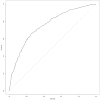Development and validation of a melanoma risk score based on pooled data from 16 case-control studies
- PMID: 25713022
- PMCID: PMC4487528
- DOI: 10.1158/1055-9965.EPI-14-1062
Development and validation of a melanoma risk score based on pooled data from 16 case-control studies
Abstract
Background: We report the development of a cutaneous melanoma risk algorithm based upon seven factors; hair color, skin type, family history, freckling, nevus count, number of large nevi, and history of sunburn, intended to form the basis of a self-assessment Web tool for the general public.
Methods: Predicted odds of melanoma were estimated by analyzing a pooled dataset from 16 case-control studies using logistic random coefficients models. Risk categories were defined based on the distribution of the predicted odds in the controls from these studies. Imputation was used to estimate missing data in the pooled datasets. The 30th, 60th, and 90th centiles were used to distribute individuals into four risk groups for their age, sex, and geographic location. Cross-validation was used to test the robustness of the thresholds for each group by leaving out each study one by one. Performance of the model was assessed in an independent UK case-control study dataset.
Results: Cross-validation confirmed the robustness of the threshold estimates. Cases and controls were well discriminated in the independent dataset [area under the curve, 0.75; 95% confidence interval (CI), 0.73-0.78]. Twenty-nine percent of cases were in the highest risk group compared with 7% of controls, and 43% of controls were in the lowest risk group compared with 13% of cases.
Conclusion: We have identified a composite score representing an estimate of relative risk and successfully validated this score in an independent dataset.
Impact: This score may be a useful tool to inform members of the public about their melanoma risk.
©2015 American Association for Cancer Research.
Conflict of interest statement
Conflicts of interest: none
Figures
Similar articles
-
Development and External Validation of a Melanoma Risk Prediction Model Based on Self-assessed Risk Factors.JAMA Dermatol. 2016 Aug 1;152(8):889-96. doi: 10.1001/jamadermatol.2016.0939. JAMA Dermatol. 2016. PMID: 27276088
-
A pooled analysis of melanocytic nevus phenotype and the risk of cutaneous melanoma at different latitudes.Int J Cancer. 2009 Jan 15;124(2):420-8. doi: 10.1002/ijc.23869. Int J Cancer. 2009. PMID: 18792098 Free PMC article.
-
High naevus count and MC1R red hair alleles contribute synergistically to increased melanoma risk.Br J Dermatol. 2019 Nov;181(5):1009-1016. doi: 10.1111/bjd.17833. Epub 2019 Jul 17. Br J Dermatol. 2019. PMID: 30820946
-
Folic acid supplementation and malaria susceptibility and severity among people taking antifolate antimalarial drugs in endemic areas.Cochrane Database Syst Rev. 2022 Feb 1;2(2022):CD014217. doi: 10.1002/14651858.CD014217. Cochrane Database Syst Rev. 2022. PMID: 36321557 Free PMC article.
-
Non-genetic risk factors for cutaneous melanoma and keratinocyte skin cancers: An umbrella review of meta-analyses.J Dermatol Sci. 2016 Dec;84(3):330-339. doi: 10.1016/j.jdermsci.2016.09.003. Epub 2016 Sep 13. J Dermatol Sci. 2016. PMID: 27663092
Cited by
-
Genetic Associations with Indoor Tanning Addiction among non-Hispanic White Young Adult Women.Ann Behav Med. 2020 Jan 1;54(1):1-9. doi: 10.1093/abm/kaz021. Ann Behav Med. 2020. PMID: 31185074 Free PMC article.
-
Indoor Tanning Dependence in Young Adult Women.Cancer Epidemiol Biomarkers Prev. 2017 Nov;26(11):1636-1643. doi: 10.1158/1055-9965.EPI-17-0403. Epub 2017 Oct 19. Cancer Epidemiol Biomarkers Prev. 2017. PMID: 29051341 Free PMC article.
-
Risk Prediction Models for Melanoma: A Systematic Review on the Heterogeneity in Model Development and Validation.Int J Environ Res Public Health. 2020 Oct 28;17(21):7919. doi: 10.3390/ijerph17217919. Int J Environ Res Public Health. 2020. PMID: 33126677 Free PMC article.
-
Combining common genetic variants and non-genetic risk factors to predict risk of cutaneous melanoma.Hum Mol Genet. 2018 Dec 1;27(23):4145-4156. doi: 10.1093/hmg/ddy282. Hum Mol Genet. 2018. PMID: 30060076 Free PMC article.
-
Melanoma risk stratification of individuals with a high-risk naevus phenotype - A pilot study.Australas J Dermatol. 2019 Nov;60(4):e292-e297. doi: 10.1111/ajd.13039. Epub 2019 Apr 2. Australas J Dermatol. 2019. PMID: 30941757 Free PMC article.
References
-
- Erdmann F, Lortet-Tieulent J, Schuz J, Zeeb H, Greinert R, Breitbart EW, et al. International trends in the incidence of malignant melanoma 1953-2008-are recent generations at higher or lower risk? Int J Cancer. 2012 - PubMed
-
- Hill D, White V, Marks R, Borland R. Changes in sun-related attitudes and behaviours, and reduced sunburn prevalence in a population at high risk of melanoma. Eur J Cancer Prev. 1993;2:447–56. - PubMed
-
- Gandini S, Sera F, Cattaruzza MS, Pasquini P, Zanetti R, Masini C, et al. Meta-analysis of risk factors for cutaneous melanoma: III. Family history, actinic damage and phenotypic factors. Eur J Cancer. 2005;41:2040–59. - PubMed
-
- Gandini S, Sera F, Cattaruzza MS, Pasquini P, Abeni D, Boyle P, et al. Meta-analysis of risk factors for cutaneous melanoma: I. Common and atypical naevi. Eur J Cancer. 2005;41:28–44. - PubMed
Publication types
MeSH terms
Grants and funding
- R01-CA66032/CA/NCI NIH HHS/United States
- R01 CA066032/CA/NCI NIH HHS/United States
- 16892/CRUK_/Cancer Research UK/United Kingdom
- R01-CA52345/CA/NCI NIH HHS/United States
- C569/A5030/CRUK_/Cancer Research UK/United Kingdom
- R01-CA92428/CA/NCI NIH HHS/United States
- K05 CA131675/CA/NCI NIH HHS/United States
- MR/L01629X/1/MRC_/Medical Research Council/United Kingdom
- P0-1 CA42101/CA/NCI NIH HHS/United States
- R01 CA092428/CA/NCI NIH HHS/United States
- R01-CA34382/CA/NCI NIH HHS/United States
- C588/A4994/CRUK_/Cancer Research UK/United Kingdom
- 10589/CRUK_/Cancer Research UK/United Kingdom


